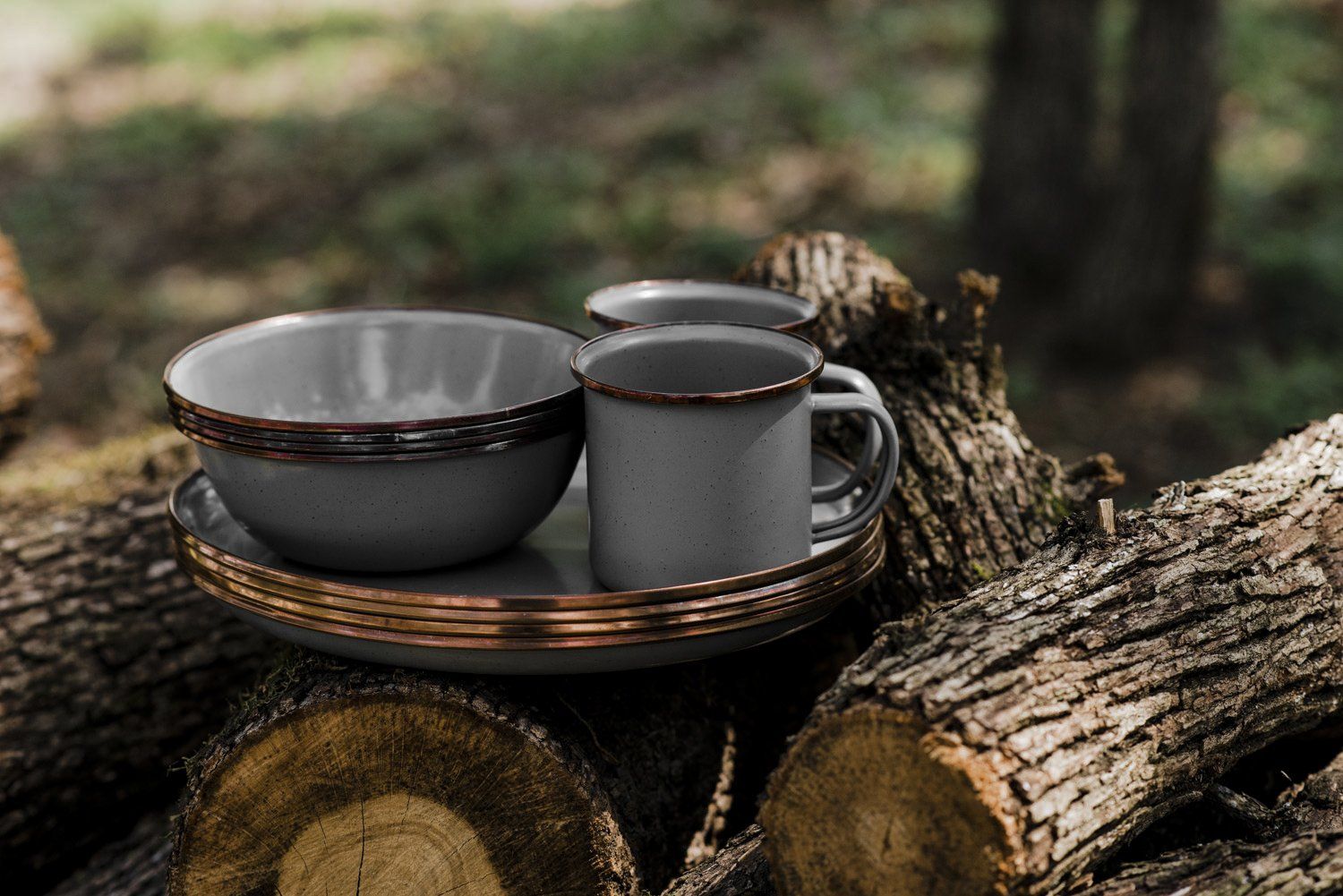Antique collectors may already know the rich history of enamelware and what makes it such a valuable commodity. But, outdoor enthusiasts probably value enamelware for other reasons, such as its packability and enduring qualities.
Enamelware has been expertly-crafted artisan wear for thousands of years longer than it's been functional gear in the wilderness. The benefits of these artfully crafted goods, from aesthetic appeal to long-lasting functionality, are what’s given enameled pieces enduring value throughout history. Enamel goods will continue to be valuable assets to any collection, whether that's antique art or outdoor cooking.

What is Enamelware or Vitreous Enamel?
Enamel, or vitreous enamel, is made by fusing powdered glass to a surface like metal, clay, or stone by firing it in a 2000 degree Fahrenheit oven. As the powdered glass heats up and melts, it binds to the iron surface in a coating-like fashion to create a smooth, non-porous, and non-stick finish.
The History Of Enameled Cookware
The earliest-made enamel involved the production of works of art, jewelry, and religious artifacts. Some of the earliest known objects were Mycenaean gold rings found in a tomb in Cyprus and date back to 1230 BC. Enamel artifacts from this period have been discovered in many regions across the world. Early artifacts appear in ancient Egypt, Greece, China, and throughout the Roman empire. When Caesar conquered Britain in 56 BC, he found that the Celts were already creating enameled objects.

In the 9th and 10th Centuries, enameled artifacts in the Middle East and Russia reflected variations in technique that created intricate stained glass effects. By the 15th Century, the skills of enamel craftsmen increased in complexity, and different styles became fashionable. The enamel work of these early eras is highly valued today because they display exquisitely detailed craftsmanship. The famous Faberge eggs, featuring jewels and intricate gold embellishments, are an excellent example. These eggs were crafted by the Russian jeweler Peter Carl Faberge in the late 1800s and are valued near $33 million today.

Enamel was often used for works of art - until the 18th Century. Germany is known for the first enameling of cast iron cooking vessels. By then, the enameling of sheet iron was already underway in Sweden. As metal production advanced in the late 1800s, enameled sheet iron improved. Metal joints and handles were more securely formed.
American Kitchenware & Enamelware
Enameled cookware came to the US after Western Europe. Around 1850, enamel-lined pots, kettles, baking tins, and ladles could be found in American homes. These were stamped from thin sheets of iron, steel, or aluminum. The Industrial Revolution drove forward the development and production of enameling. Nearing the end of this boom enameled cooking vessels were commonplace. On the heels of the Industrial Revolution, a surge of competitive craftsmanship began to change the aesthetics of American kitchenware. Out of this came a huge range of new designs. Folks could choose between the famous speckled design and the mottled look; Graniteware, which had a speckled or mottled effect to resemble the look of granite stone; or traditionally-made enamelware, which offered a solid color finish.

Advancements in metal sheet enamelware occurred. This improved the performance of cooking vessels even more and led to enamelware becoming the first mass-produced American kitchenware. Much lighter than the average kitchenware, easier to clean, and less fragile than china, enamelware was very popular. Part of what made enamel so valuable was the realization that it could create a non-stick surface, perfect for frying and cooking.
At the time when mottled enamel was a huge success in America, some countries stuck to a simpler look. Classic British enamel was typically white with navy trim, though deeper colors were used. Sweden had a lot of cream with green edging. Other countries had a mixture of plain and speckled, with folk art decoration, like floral motifs.

In the late 1930s, enamel kitchenware began losing its prime position in the American marketplace due to the rise of plastic, aluminum, stainless steel, and pyrex for kitchen cookware. Many enamelware pieces were lost to World War II scrap metal drives. Today, the once plentiful kitchenware is harder to find, making vintage enamelware of this era a favorite of designers and antique collectors.
However, the popularity of enameled solid cast iron cookware (as opposed to thin sheet metal enamelware) did not take off until the early 1950s, when a French company, Le Creuset, began exporting its pots, pans, and casserole dishes to the United States. La Creuset inspired a resurgence of vitreous enamelware being manufactured again in the United States during the 1960s and 1970s.
Is Your Enamelware Vintage?
A genuine antique may have its maker's name or date fired into the glaze on the bottom. But as it was not a precious item when made in the early 20th Century, it was common not to mark the pieces.

Vintage enamelware can be dated by the heft of the piece. Enamelware crafted in the early 20th Century is noticeably heavier than ones made after World War II. A tinny sound produced from tapping the bottom of a pot can indicate it was likely made in the 1970s. Vintage enamel is so highly valued today that antique appraisers may appraise a century-old muffin tin for more than $1,500 if it is in perfect condition, has a rare shape and color, or the original label. (Although more commonly found teapots and mixing bowls in near-mint condition might be valued between $30 and $300.) Though enamelware was briefly eclipsed by other materials nearly a century ago, it is still highly regarded as sustainable alternative cookware.
Taking Your Enamelware Outdoors & Camping
Outside of the domestic home, enamelware offers many benefits to those traveling in the outdoors. Enamelware is lightweight, stackable, and therefore packable, which makes it ideal for camping and backpacking. Because the interior is made of metal, enamel pieces are sturdy and maintain their durability for many years, if not for many lifetimes. The fused glass coating lends itself to being cleaned easily, and the outer finish provides a non-stick surface and protects the steel from rusting, rendering maintenance nearly effortless.
Favored by collectors, designers, and outdoor enthusiasts seeking to benefit from its form and function, enamelware remains a valuable addition to any kitchenware collection. It’s entirely possible to own cookware that is both a collector’s item yet strong enough to use on a lifetime of outdoor expeditions. Lastly, we all can enjoy the affordability of such long-lasting and beautiful pieces.



